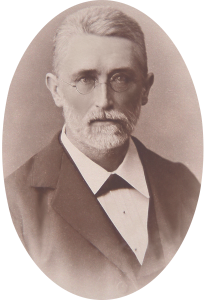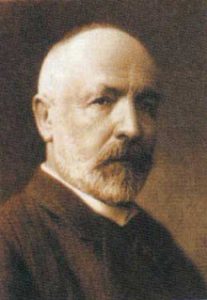What have the founders of evolutionary theory got to do with two great German mathematicians? Apparently nothing, but wait until you read the letter from one of Dedekind’s nephews written in 1887.
The story of how Alfred R. Wallace independently discovered the theory of natural selection, and how this encouraged Darwin to finally publish his ideas, is well known. Until 1858, Darwin had been slowly perfecting and writing up his theory, but everything changed when he received an essay from Wallace (who was then living in Borneo) describing his version of the same idea. A year later, Darwin had finished a ‘synopsis’ of his work, published in 1859 as On the Origin of Species. But the elegant and gentlemanly way in which the conflict of priority between the two naturalists was resolved is also famous: Darwin’s friends acted to safeguard his rights of priority, as they had known his thoughts for some time, and decided to publish Wallace’s essay along with extracts from a Darwin manuscript written in 1844. They arranged a session of the Linnean Society at which both papers were presented, on 1 July 1858, and from which On the Tendency of Species to Form Varieties was published in the journal. In any event, this journal publication had a much lesser impact than Darwin’s later book, whose first edition sold out in one day.
 Richard Dedekind would have needed similar action from his colleagues and friends to secure priority rights over the introduction of mathematics based on infinite set theory. But this never happened. Unlike the temperamental Cantor, who was eager to publish his new ideas, Dedekind was always slow and cautious: in his case, a 14-year delay between conception and publication was quite normal, which is true for his theory of real numbers (devised 1858, published 1872) and his theory of naturals, for example. For comparison: in one important case, the Grundlagen of 1883, Cantor managed to allow just six months (!) to pass between the first vision of new ideas and their publication.
Richard Dedekind would have needed similar action from his colleagues and friends to secure priority rights over the introduction of mathematics based on infinite set theory. But this never happened. Unlike the temperamental Cantor, who was eager to publish his new ideas, Dedekind was always slow and cautious: in his case, a 14-year delay between conception and publication was quite normal, which is true for his theory of real numbers (devised 1858, published 1872) and his theory of naturals, for example. For comparison: in one important case, the Grundlagen of 1883, Cantor managed to allow just six months (!) to pass between the first vision of new ideas and their publication.
Actually, those of us who insist – following Zermelo, 1908 – that the theory of sets was created by Dedekind and Cantor are in the minority and stand to lose. Our voice is almost inaudible, and everyone knows – Google and Wikipedia say so – that Cantor was the only true creator of the theory. Hausdorff also said this in the dedication of his magnificent book of 1914; however, we can read that “Dedekind was sympathetic to Cantor’s theory of ensembles, as this quote illustrates…” (sic!, from the biography in MacTutor). However, twentieth century set-theoretic and structural mathematics owes its methods no less to Dedekind than to Cantor; and it is a fact that Dedekind started working with infinite sets, equivalence classes, etc. from 1857, and published a very influential contribution (including e.g. the idea of isomorphism) in 1871, before any of Cantor’s articles.
 But well, let’s go straight to the promised letter. I encountered it in 1997, when I was paying a visit with a friend to a descendant of the Dedekind family, Ilse Dedekind, who was then somewhat surprised and puzzled by the contents of the letter. It was written by Adolf “Atta” Dedekind, the mathematician’s nephew, to his aunt Julie, who lived with Richard himself. Atta was studying law in Munich, and here is what the letter said:
But well, let’s go straight to the promised letter. I encountered it in 1997, when I was paying a visit with a friend to a descendant of the Dedekind family, Ilse Dedekind, who was then somewhat surprised and puzzled by the contents of the letter. It was written by Adolf “Atta” Dedekind, the mathematician’s nephew, to his aunt Julie, who lived with Richard himself. Atta was studying law in Munich, and here is what the letter said:
Dear Aunt Julie:
I want to start today directly with a little story, which Mr. Dr. Pauly – whose public course on Darwinism I attend – told us at the beginning of his lesson, and which interested me greatly, as it will with you and Uncle Richard, if you don’t already know it (naturally, I don’t know if you do). Shortly before the publication of his well-known work, Darwin received a pamphlet sent by a scholar friend, named Wallace, in which the same theories are presented in broad terms (certainly in a very brief but by no means superficial way) to whose establishing and demonstration he (Darwin) had dedicated all his life. On hearing this story I thought immediately of Uncle Richard and Mr. Kantor [sic, JF], and I hope that this matter will develop as beautifully as Darwin’s! For as Darwin showed that he had had the same vision decades earlier, and had only delayed publication for so long to continue completing his theories, Wallace (who had also composed his work in the Malaysian archipelago, while Darwin was in England) openly declared that he could never and would never attempt to claim priority for these theories for himself. For although he had independently arrived at similar results to those of Darwin, he had to withdraw completely in view of the brilliant development, etc. etc. of Darwin’s work…
Atta
The letter is dated 20 Nov. 1887 and can be found in German version in Ilse Dedekind’s book, Unter Glas und Rahmen (Braunschweig, Appelhans, 2000), p. 223.
The date 1887 is interesting: it was four years earlier that Cantor had published his novel idea of the transfinite numbers, in the Grundlagen, but it was precisely in 1887 that Dedekind was checking the proof-pages of his famous book What are numbers and what are they for?, which prefigures several of Zermelo’s axioms and develops the theory of \(\mathbb N\). Just in case there is any doubt that Cantor and Dedekind themselves saw a question of priority: in a letter to his friend and colleague Heinrich Weber, January 1888, Dedekind comments bitterly that Cantor had complained to him that already in 1877 he had pointed out the difference between finite and infinite sets; to which he adds: “much could be said about this… but I too have no desire to get involved in a conflict of priorities”. (Cantor was suggesting that he had already indicated what constitutes the core of the definition of Dedekind-infinite sets; but in 1877 he did not give any explicit definition, and Dedekind tells us that, when the two discussed the subject in 1882, Cantor did not believe a simple definition was possible and was “very surprised when, induced by his doubts and at his request, I communicated my definition to him”.)
If we identify set theory with the ZFC axioms, it must be said that these principles are no more linked to Cantor’s works than to those of Dedekind. Some of them have more connection with Cantor’s ideas, as it happens with the Replacement axiom; some others are more linked to his colleague, as it happens with the Infinity axiom, which Zermelo himself called “Dedekind’s axiom”. As for the Axiom of Choice (the C in ZFC), it is interesting to note that G. H. Moore in his exhaustive study has found precisely the first two implicit uses of it in a work by Dedekind and one by Cantor.
Last year was the centenary of Dedekind’s death, and next year will be Cantor’s centenary. So 2017 seems like a good date to celebrate the great mathematical contribution that both of them made, leaving aside the personal tensions and reticence that existed between them during their lifetime.
To know more: The Early Development of Set Theory, https://plato.stanford.edu/entries/settheory-early/

OMG this is wunderbar!!!
Being a fan of Darwin and Dedekind, I have been looking for the connection between Darwinism and German mathematicians in the latter 19th century for a long time already, and this is just so amazing!
Thank you very much for writing this!!
Gracias Haina! Es genial saber que tenemos lectores desde Singapore! Y por cierto, he visto tu blog The Cut and the Cat y me ha parecido interesante (https://blog.nus.edu.sg/deka/). Saludos,
Magnífica entrada. Hace un par de días acabé de leerme un libro muy recomendable sobre la historia del infinito donde se cuenta el trabajo de Dedekind y Cantor y otros muchos titulado “Todo y más: una breve historia del infinito” cuyo autor es David Foster Wallace. Una curiosa coincidencia es es que su autor tiene el mismo apellido que Alfred R. Wallace.
Muchas gracias, Renato. No conozco ese libro, pero desde luego hay algunos buenos sobre este tema. Y ya que hablamos de libros, no quiero dejar de mencionar que hay en castellano ediciones de los maravillosos trabajos de Georg Cantor (Ed. Crítica, 2006) y Richard Dedekind (Alianza, 2014).
Gracias Pepe, los buscaré.